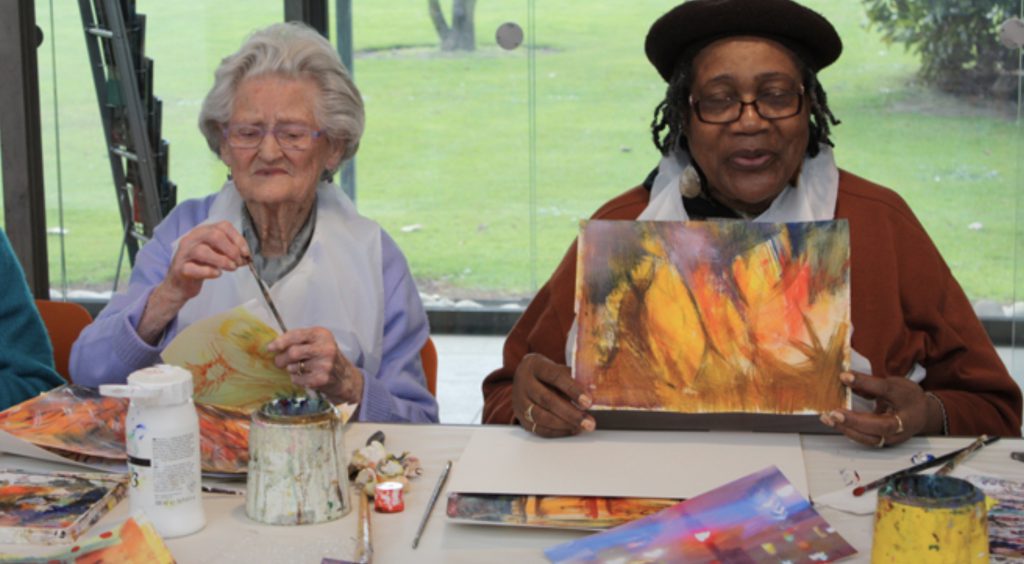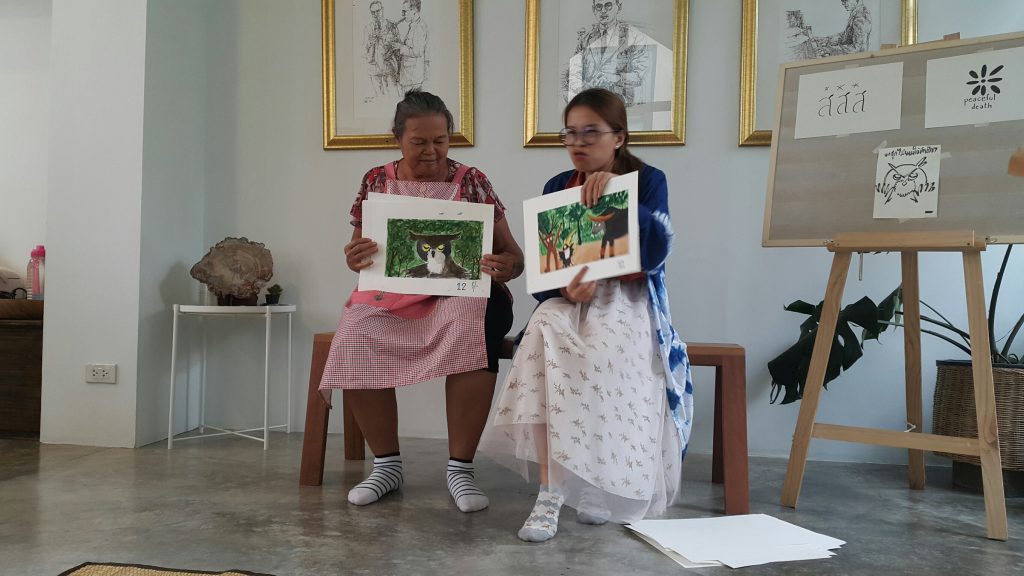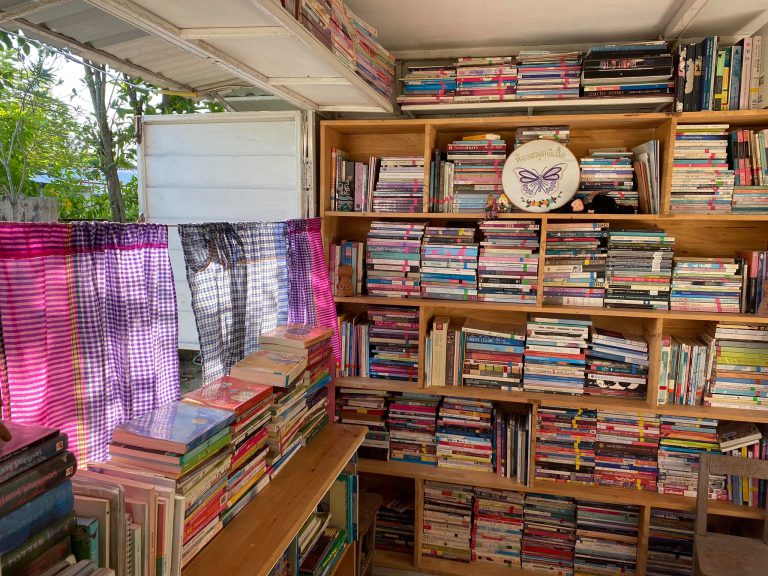Story: Pongkamon Surat
To create a work of art, many people might assume, requires talent, time and creativity. That might be the definition of art in fine arts and exclusive circles. Another perspective, however, sees life and art is inextricably intertwined, and art as an exercise that captures beauty, imagination and intellectual life. Everyone can draw, trace, flick, color and paint in order to express their interpretation of beauty. On some occasions, art is used as a tool for understanding oneself and others, and bringing together the stories of our lives — including stories of death.
Take, for example, 20 colorful watercolor paintings that emerged from the tips of brushes held by people of different ages who attended “The Owl Refuses to Help”, an illustration workshop hosted by Peaceful Death. None of the artists in the group had a formal foundation in drawing or watercolor; they were mothers, fathers and children who had invited each other to attend in the spirit of experiencing something new: learning about death through an art practice over four workshops.
“The Owl Refuses to Help” is the title of a story with an elderly owl as its main character. The owl is the wise voice of counsel for the animal inhabitants of a large forest. But one day, the owl responds by shaking its head, refusing to offer even another word of advice to the other animals, because it had fallen ill and was dying. The animals small and large were surprised and panicked, for it was as if they had lost the central pillar of their lives. There isn’t a fixed ending to the story, which is collectively written by the workshop participants.

“The relationship between the elderly and their families is key to caregiving in the later stages of life,” says Ekapop Sithiwanthana, one of the workshop organizers. “Quality time is vital to having a good relationship. I chose an art activity because it gets the elderly and their families to spend a long time with each other. It is a point of connection between generations. We can put in any kind of narrative for the story. For this workshop, we chose a story that highlights the value of the elderly, planning for death, having good relationships and dying peacefully, which created conservations between mothers and fathers and their children as they created their stories. The process of illustrating the stories gets everyone talking about death, because there is a character that is near death. The elderly and their family members have to think about what they want to do with this character and the other animals. We can use the experience of talking about this topic with our parents while illustrating the story, when we have this conversation when the family is dealing with sickness and pain in the future. Also, time spent making art together always becomes a good memory for the family”.
Bossa-nova music intermixes with the sound of raindrops against the window. It is the kind of atmosphere that inspires one to keep dancing with the paintbrush without pause, hand and eye in synchrony, absorbed in the application of colors to the page. During this period of time, the elderly and their families are truly working together, sharing in an experience that many families might not have had before. The workshop involves drawing, painting and storytelling in turns. In addition to following their personal artistic tastes, family members listen to each other’s opinions and share words of encouragement. The workshop prompts participants to meditate on death, separation and loss, and letting go, which are themes embedded in the story that each family has brought to completion with their own hands. The workshop concludes with a reflection on death, which is a subject some families may not have found the right moment to discuss. Reflecting on death through story-telling is a way of facing the truth of life through the imagination. If we look closely, we are all either the elderly owl or the other forest animals in the story.

Arts for Seniors in Other Countries
There are arts activities like these in many other countries, such as in England: since 2005, doctors and the Oxford Institute of Population Ageing have collaborated with the London-based Dulwich Picture Gallery and more than 65 community networks to organise an arts workshop for seniors called “Good Times”. Recognizing the multifaceted benefits of the arts for seniors — from stress-relief to improving physical and spiritual well-being — the organizers have expanded the project to target seniors with depression and Alzhemier’s, as well as develop intergenerational creative workshops to bring together youth and seniors.

The “Good Times” workshop in England
Organised by the Dulwich Picture and more than 65 community networks
from: www.dulwichpicturegallery.org.uk/learning/older-people/
In America, a non-profit organisation called ARTS by the People hosts public events for seniors and youth that use art, a powerful tool for self-expression, to build different communities that bridge generational gaps between people interested in the arts. Experts of different artistic disciplines lead workshops for groups of 40 people that are free of charge and where all are treated equally. The workshops are held in public spaces such as schools, art studios, bookstores, cafes and senior centres, and encompass a variety of art forms such as water-color painting, poetry, photography, short-film, narrative dance, flower-arranging and jewelry-making.
The activities described above have the capacity to improve the capabilities of senior participants and forge connections between people of different generations — just like “The Owl Refuses to Help” illustration workshop, though the workshops’ goals may differ according to the nature of the activity. The emphasis of the illustration workshop was to give seniors and their families quality time with each other. When many families and organizers gather, a small community emerges that shares in beauty and smiles for a window of time, while meditating on death through the language of images and stories. In this space, death is imbued with gentleness and inspires positive feelings. Seniors get to leave home and participate in an activity within a relaxing and creative atmosphere. This is reflected in the participant’s observations at the end of the workshop:
“Looking at it from my dad’s perspective — he usually isn’t like this. He was laughing and relaxed. I’m happy that I made him laugh, that I could see how gentle and talented he is”.
“I brought my mother here to relax, learn watercolors and make some new friends. I got to see my mom in a different social environment than usual”.
Family members of all ages — or to take it further, entire communities — can join together to make art. Art is vehicle of dialogue; it opens up a space of freedom, and is a beneficial tool
Note: This is a written account of the “The Owl Refuses to Help” illustration workshop organised by Peaceful Death at the Present Moment shop on 6, 17, 29, 24/09/2018.
Citations:
- Ekapop Ekapop Sithiwanthana, knowledge manager at Peaceful Death. (Interviewed on 24/09/2018).
- ARTS by the People. Arts Programs for Senior Citizens. Retrieved September 24, 2018, from http://artsbythepeople.org/site/arts-programs-for-senior-citizens/
- Harper, Sarah.; & Hamblin, Kate. Oxford Institute of Ageing Report Good Times: Art for Older People at Dulwich Picture Gallery. Retrieved September 24, 2018, from https://www.ahsw.org.uk/userfiles/Evidence/This%20Is%20LivingGood%20Times%20A rt%20for%20Older%20People-1.pdf






